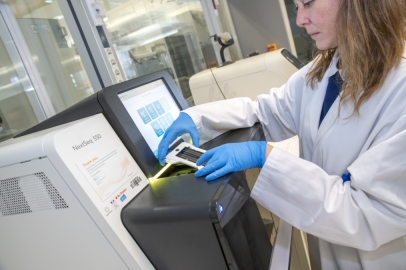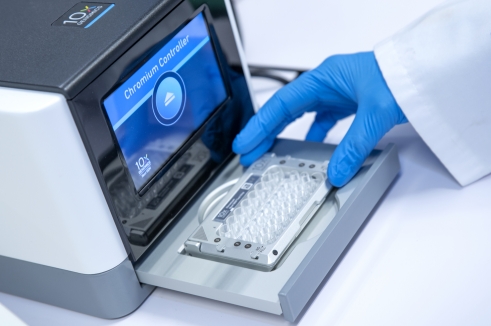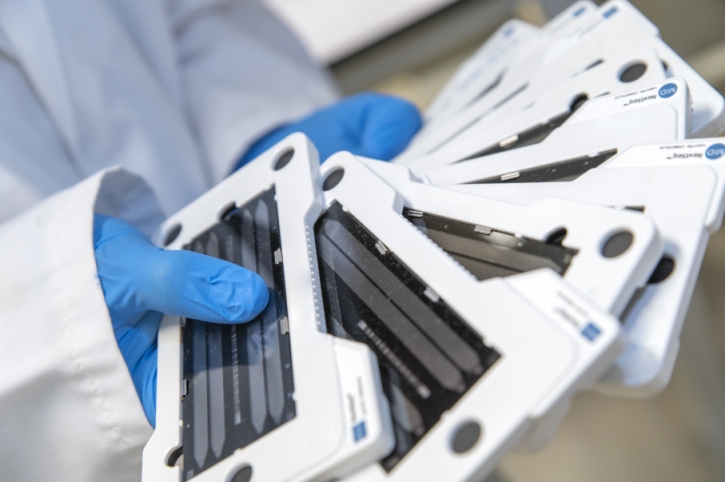High-throughput sequencing
The NGS platform provides I-Stem with high throughput genome and/or transcriptome sequencing services as well as scientific and technical support to propose the most suitable sequencing strategies for the projects
DNA sequencing, and more particularly high throughput sequencing, is a technology that allows us to study and better understand the rare genetic diseases on which we work at I-Stem. Depending on the techniques developed, it is possible to search for new mutations responsible for genetic diseases (DNAseq ) or to study the expression of genes in a healthy and/or pathological context (RNAseq – transcriptome study). At the end of the bioinformatics analysis, these data can lead to the identification of new therapeutic targets.
The platform has a NextSeq 550 Illumina sequencer as well as equipment for sample extraction, quantification and quality control (Qiacube – Qiagen / BioAnalyzer – Agilent / QuantStudio 12K & 7K – Thermo Fisher Scientific). Since 2020, the platform also offers single cell sequencing (Single cell RNAseq – Chromium 10X genomics)
In addition to the service activity, the platform conducts R&D programs such as the development of new sequencing techniques or new bioinformatics tools (databases, NGS analysis pipelines, etc.)
Tool developed by the platform:
SIStemA: A large and standardized collection of transcriptome data sets for human pluripotent stem cell research
Our GitHub page : I-Stem-CECS
Team members
Margot Jarrige
Platform Manager
Margot joined I-Stem in 2014 and gradually specialized in throughput sequencing and gene regulation analysis. Margot holds a Master’s degree in “R&D Biotechnology” from the University of Paris VI and is doing a PhD.
Hélène Polvèche
Bioinformatics Engineer
Hélène arrived in 2015. Integrated in the NGS platform since 2017, she is specialized in “Omics” data as well as in web tools development. Hélène holds a Master’s degree in Structural Biology and Bioinformatics.
Justine Rousselot
Platform Technician (CECS)
After a DUT in Biological Engineering and an initial specialization in robotics and NGS, Justine joined I-Stem in February 2024, as a platform technician. She will be working in both the High-Throughput Screening (HTS) and High-Throughput Sequencing (NGS) teams.
Collaborations
The PSMN is a scientific platform of the ENS de Lyon hosting high performance computing resources (HPC). It provides immediate and flexible access to significant computing resources (12,000 cores, end 2019).
Academic network of platforms dedicated to genomic analysis, i.e. the study of genomes and transcriptomes, in all types of living organisms. It brings together academic platforms attached to the Life Sciences Department (SDV) of the University of Paris Saclay.
Publications
The AMPK-related kinase NUAK1 controls cortical axons branching by locally modulating mitochondrial metabolic functions.
21 March 2024
Nature communications
Mono- and Biallelic Inactivation of Huntingtin Gene in Patient-Specific Induced Pluripotent Stem Cells Reveal HTT Roles in Striatal Development and Neuronal Functions.
01 January 2024
Journal of Huntington's disease
SplicingLore: a web resource for studying the regulation of cassette exons by human splicing factors.
21 December 2023
Database : the journal of biological databases and curation
Equipments

Nextseq 550
Sequencer of the Illumina range, it allows 30X sequencing of a human genome or 40 transcriptomes in parallel. This equipment offers a flexible throughput allowing the development of a wide range of sequencing applications. (Funded by Genopole and UEVE)

Chromium Controller
It uses microfluidic technology to isolate individual cells in a sample and thus allows the study of gene regulation at the single cell level (UEVE funding)
Hamilton Micro lab Star
Pipetting robot designed to automate the preparation of NGS libraries, guaranteeing better precision and reproducibility for sequencing projects. (Genopole funding)
Qubit 2 Fluorometer
Spectrofluorometer allowing a fast, precise and sensitive quantification of nucleic acids and proteins.
Serveur
The platform is equipped with a computing server (Ubuntu OS) with 38 cores, 250 GB of RAM and 95 TB of disk space.
Qiacube
It allows the automation of a large number of nucleic acid extraction protocols (DNA, mRNA, tRNA, miRNA …)
Quantstudio 12k et 7k
These are real-time PCR instruments for studying the expression of genes of interest in 96- or 384-well format. Compatible with SYBER and TaqMan chemistry, the Quantstudio offers a wide range of genomic applications. (Genopole funding)
Bioanalyzer 2100
This equipment uses micro-fluidic technology for the analysis of nucleic acid or protein samples. The unique resolution of this device allows quality control of biological samples as well as the identification of small genomic insertions or deletions.
Ultracentrifugeuse Optima-XE
This device is used to centrifuge biological samples at very high speed to isolate certain particles (UEVE funding)
NanoSight NS300
It allows the visualization, qualification and quantification in real time of nanoparticles present in a biological fluid (UEVE funding)

